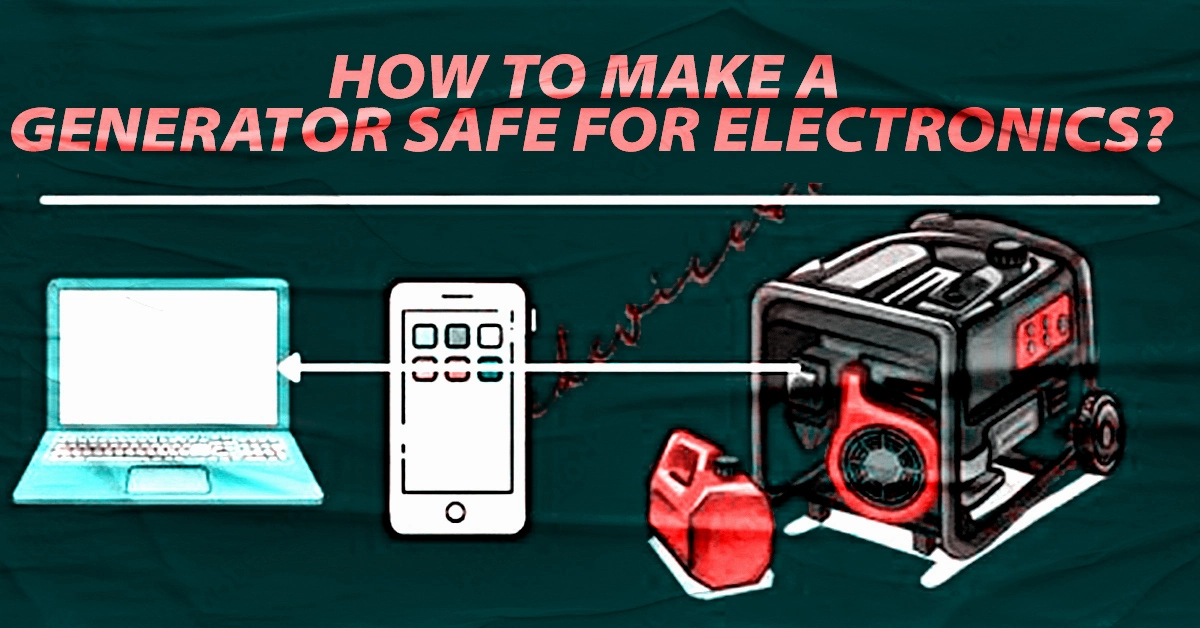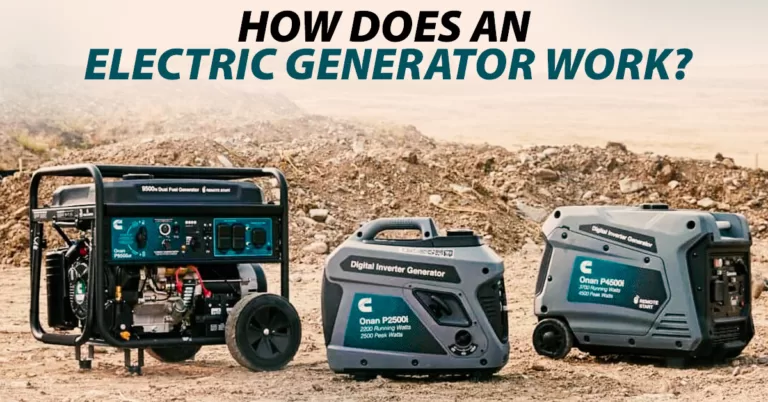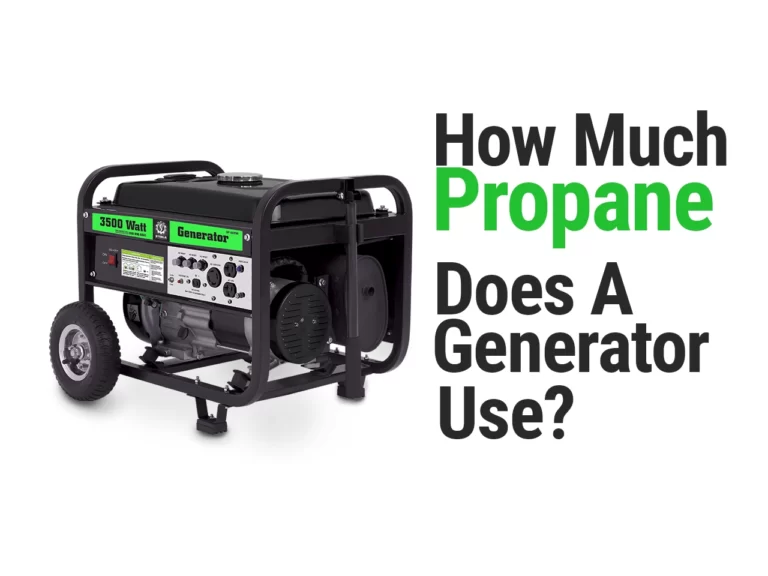How to make a Generator Safe for Electronics?
It is crucial to check that a generator is safe for electronics before utilizing it. The unrestrained electrical energy produced by generators has the potential to harm connected electronic equipment. Data loss, equipment damage, and even fire risks could occur from this. Utilizing a generator that is safe to use and complies with applicable safety regulations is essential to avoid these dangers. How to make a generator safe for electronics In order to safeguard electronic devices linked to the generator from voltage spikes and other electrical disturbances, it is also crucial to employ suitable electrical connections and surge protection devices.
Problems with Generators and Electronics
Inconsistent Power Generation
The voltage and frequency of the electrical power delivered might fluctuate since generators are frequently built to produce power in variable amounts. For sensitive electronic equipment that depends on a steady and reliable power source, such as computers and other machinery, this irregular power generation might be problematic.
Harmonic Distortions In Power
In the electrical electricity that generators produce, harmonic distortions can lead to erratic voltage and frequency spikes that can destroy electronic devices.
Resulting in Power Fluctuations And Surge
Power surges and fluctuations caused by irregular power generation and harmonic distortions can injure or completely destroy delicate electronic equipment. These surges can also result in data loss and corruption, which can have detrimental effects on organizations and people who depend on electronic equipment for critical tasks.
Damage to Electronics
Inadequately constructed or maintained generators can seriously harm electronic equipment, necessitating costly repairs or even entire equipment replacement. A generator that is improperly grounded can also be a severe safety risk, putting people and animals who come into touch with it at risk of electrocution.
Solutions To Protect Electronics
In times of calamities or power outages, generators are a crucial source of backup power. However, the electricity produced by generators is frequently erratic, resulting in surges and oscillations that can damage delicate electronic equipment. It’s crucial to use the appropriate tools and to set them up properly if you want to secure these gadgets. This article will examine some of the best safeguards for electronics against generator-related issues.
Use a Surge Arrester
Definition of Surge Arrester
A surge arrester is a tool used to safeguard electrical equipment from surges, which are strong voltage spikes.
Functioning Of Surge Arrester
Surge arresters prevent excessive electricity from reaching and harming electrical equipment by directing it to the ground. They are often put near the electrical equipment that has to be protected or at the service entry.
Importance Of Using A Surge Arrester
Surge arresters are essential for shielding electronic equipment from large voltage spikes that could harm it permanently. Expensive electronics like televisions, computers, and appliances can be completely destroyed without a surge arrester in a matter of seconds.
Other Devices To Use with A Surge Arrester
For optimal safety, surge arresters are frequently used in conjunction with other devices like surge protectors and uninterruptible power supplies (UPS).
Use A Surge Protector
Definition Of Surge Protector
The purpose of a surge protector is to shield electrical equipment against power outages and voltage spikes.
Functioning Of Surge Protector:
Surge protectors prevent overvoltage from reaching and harming electrical equipment by diverting it to the ground. The equipment is normally plugged into the surge protector after they have been plugged into a power outlet.
Importance Of Using A Surge Protector
Surge protectors are crucial for shielding delicate electronic equipment from voltage spikes and power surges that could permanently harm it. They are an affordable option for safeguarding electronics, and for optimal security, they can be combined with additional safety measures.
Considerations When Buying A Surge Protector
Think about the required number of outlets, the wattage capacity, and the response time when selecting a surge protector. Choosing a surge protector with a warranty and a high surge protection rating is also crucial.
Here are some best surge protectors available on Amazon.
Proper Installation of a Surge Protector
A surge protector must first be plugged into a wall outlet before the equipment can be connected. If you find out more, make sure to read the manufacturer’s instructions.
Use An Uninterruptible Power Supply (UPS)
Definition of UPS
In the event of a power loss, electrical equipment can get backup power via an uninterruptible power supply (UPS).
Functioning of UPS:
In the event of a power loss, a UPS can power the device by using batteries as backup power. The UPS also controls the voltage, ensuring that the equipment receives clean, dependable power.
Types of UPS to Consider:
Online, line-interactive, and offline UPS are only a few of the different varieties available on Amazon. The particular needs and specifications of the equipment that has to be protected will determine the type of UPS to select.
Importance of Using a UPS:
A UPS is a crucial piece of equipment for safeguarding delicate electronic equipment from power outages and voltage changes. It offers a backup power source, guaranteeing that the machinery continues to function in the event of a power interruption.
Proper Installation of a UPS:
Follow the manufacturer’s recommendations while installing a UPS, which include connecting the UPS to the equipment and a power source.
Inverter Generator
Definition Of Inverter Generator
An electronic inverter system is used in an inverter generator, a particular kind of generator, to produce AC electricity. Inverter generators directly produce AC power as opposed to conventional generators, which first produce DC power before converting it to AC.
Functioning Of Inverter Generator
With the aid of an electronic inverter system, inverter generators transform the DC power generated by the generator’s alternator into pure AC electricity. A constant and consistent supply of power is produced by the inverter system, which modifies the frequency and voltage of the AC power to suit the needs of the connected devices.
Advantages of Inverter Generator:
- Clean and Stable Power: Clean, consistent power that is safe for delicate electrical gadgets is produced by inverter generators.
- Fuel Efficiency: Because they only provide the electricity that is required, inverter generators use less fuel and emit fewer emissions than conventional generators.
- Quiet Operation: Since they are usually much quieter than conventional generators, inverter generators are appropriate for usage in residential and recreational settings.
- Portability: Because they are small and light, inverter generators are simple to use and transport in a variety of situations.
Cost of Inverter Generator:
Depending on the generator’s size and functionality, the price of an inverter generator might vary significantly. While more powerful, larger models might cost several thousand dollars, smaller, portable inverter generators can range in price from $300 to $800. It is crucial to take into account the value of clean and stable power, fuel efficiency, and quiet operation, as well as the particular requirements of your application when calculating the cost of an inverter generator.
Use a Generator with a Built-In Voltage Regulator
Definition Of Built-In Voltage Regulator
The voltage output of a generator can be managed and regulated by a generator with an integrated voltage regulator. Your devices will be protected by this function from harm caused by voltage changes.
Functioning Of Built-In Voltage Regulator
Regardless of the load on the generator, the voltage regulator in a generator makes sure that the voltage output is constant and within the desired range. By doing this, overloading and harm to the associated equipment are deterred.
Advantages
Your electronics will be shielded from voltage surges and fluctuations if you use a generator with an integrated voltage regulator. This kind of generator also offers a more steady source of power, which makes it perfect for usage with delicate devices.
Cost:
The price of a generator with an integrated voltage regulator varies according to the generator’s size, power output, and features. But the cost of this kind of generator is often more than that of a regular generator.
Install an AVR (Automatic Voltage Regulator)
Definition Of AVR (Automatic Voltage Regulator)
A device called an Automatic Voltage Regulator (AVR) automatically controls a generator’s voltage output. It aids in sustaining a constant voltage output regardless of fluctuations in the generator’s load.
Functioning:
An AVR keeps track of the voltage output of a generator and makes required adjustments to keep it within the predetermined range. Normally, it is positioned between the generator and the electrical load, such as appliances or gadgets.
Importance:
Installing an AVR is crucial because it helps shield your electronics from damaging voltage surges and oscillations. Additionally, an AVR offers a more reliable power source, which makes it perfect for use with delicate devices.
Cost:
The dimensions and features of an AVR determine its price. However, it is a relatively inexpensive solution that can offer your electronics a lot of protection.
Run Your Generator Through a Power Conditioner
Definition Power Conditioner
A power conditioner is a tool that aids in controlling a generator’s power output. It is made to filter out electrical noise and fluctuations, giving your devices a clean and reliable power source.
Functioning Power Conditioner
Between the generator and the load, such as electronics or appliances, is often installed power conditioner. It assists in controlling the generator’s power output by removing electrical noise and fluctuations.
Importance Power Conditioner
It’s crucial to run your generator through a power conditioner since it helps shield your equipment from voltage spikes and fluctuations. It also offers a more reliable power source, which makes it perfect for use with delicate electronics.
Cost
A power conditioner’s price varies according to its size and characteristics. However, it is a relatively inexpensive solution that can offer your electronics a lot of protection.
Install a Ground-Fault Circuit Interrupter (GFCI)
Definition Of GFCI
A Ground-Fault Circuit Interrupter (GFCI) is a tool that, by spotting ground faults, aids in preventing electrical shock and fires. It is frequently put in locations with electrical equipment, like next to a generator.
Functioning Of GFCI
A GFCI keeps track of the circuit’s electrical current. To avoid electrical shock or fire, it instantly cuts off the power if it notices a ground fault, such as a short circuit.
Importance Of GFCI
You and your devices can be protected against electrical shock and fires by installing a GFCI. In locations where electrical equipment is used, such as next to a generator, it is especially crucial.
Cost:
A GFC I’s price varies according to the device’s size and characteristics. In contrast to the price of fixing or replacing broken equipment, it is a comparatively cheap solution. Simple GFCI devices range in price from $20 to $50, while more sophisticated ones can cost as much as $100.
Implementing Good Grounding Practices
The term “grounding” describes the electrical link between a device and the earth, which serves as the electrical system’s reference point. In the event of a failure or surge, proper grounding procedures guarantee that electrical energy is dispersed securely and effectively, protecting equipment and ensuring safety.
Steps To Implement Good Grounding Practices:
- Find out what kind of grounding your equipment needs.
- Make sure that all of the grounding connections are firmly fastened.
- Make sure to use the right kind of grounding conductor, like copper or aluminum.
- To ensure a proper electrical connection to the earth, use a ground rod.
- Check the equipment and grounding connections often for wear or damage.
Considerations When Implementing Good Grounding Practices:
- Ensure that you adhere to local electrical laws and regulations.
- Always utilize the right equipment and procedures while creating grounding connections.
- To guarantee effective operation, grounding connections should be periodically inspected and tested.
Regular Maintenance and Testing
Your generator has to be tested and maintained regularly to continue running safely and effectively. This entails inspecting and maintaining all electrical parts, like wiring and connections, as well as making sure that any safety equipment, like circuit breakers, is in good working order.
What to Test for during Maintenance and Testing:
- Electrical output voltage and frequency
- Fuel system, including fuel lines, filters, and pump
- Engine performance and oil level
- Engine temperature and cooling system
- Generator control panel, including circuit breakers and fuses
Steps to Conduct Regular Maintenance and Testing:
- Visually inspect the generator and all of its parts.
- Examine the oil level and add more if necessary.
- If it’s unclean, check the air filter and replace it.
- Check the spark plugs and replace them if necessary.
- Using a voltage meter, check the generator’s electrical output.
Considerations when Conducting Regular Maintenance and Testing:
- Always adhere to the suggested maintenance schedule provided by the manufacturer.
- When performing maintenance and testing, use the right equipment and techniques.
- Keep thorough records of all your testing and maintenance procedures.
These are only a handful of the numerous options available to safeguard electronics from issues related to generator use. It’s essential to put one or more of these ideas into practice if you want to make sure that your electronic equipment is secure and lasts a long time. You can be sure that your devices will work properly even when there are power outages or other disruptions by taking the required safeguards.
FAQs
-
What Is A Surge Arrester And How Does It Protect Electronics?
Electronics can be shielded against voltage surges brought on by lightning strikes or other electrical disturbances using a surge arrester. It operates by directing excessive voltage into the earth, where it is safely dissipated, and away from the protected equipment.
-
What Is A Surge Protector And How Does It Differ From A Surge Arrester?
A surge protector is a piece of equipment used to guard electronics against power surges brought on by changes in the electrical supply. It functions by capping the voltage at a safe level by restricting the amount of voltage that can reach the protected device. A surge protector differs from a surge arrester in that it restricts the passage of the excess voltage to the protected equipment rather than directing it into the earth as a surge arrester does.
-
Why Is It Important To Conduct Regular Maintenance And Testing On A Generator?
To make sure a generator is operating properly and to help prevent damage to electronics, routine testing, and maintenance are crucial. The generator should be examined for signs of wear and tear during maintenance and testing, and any required repairs or replacements should be undertaken to guarantee that it is operating securely and effectively. The generator should also be put to the test to make sure it is producing electricity within a safe range and that it is not damaging any attached devices.
-
What Is An Uninterruptible Power Supply (UPS) And How Does It Protect electronics?
When there is a power outage, electronics can use a UPS (uninterruptible power supply) as backup power. It functions by giving the protected equipment a consistent, steady power source, helping to guard against harm brought on by abrupt power fluctuations or outages.
-
What Is An Inverter Generator And How Does It Protect Electronics?
A type of generator called an inverter generator provides safe, dependable electricity that is appropriate for delicate devices. It operates by converting the generator’s DC power into AC electricity, which is then adjusted to maintain a constant voltage and frequency. This helps shield electronic equipment from harm brought on by power surges or fluctuations.



















